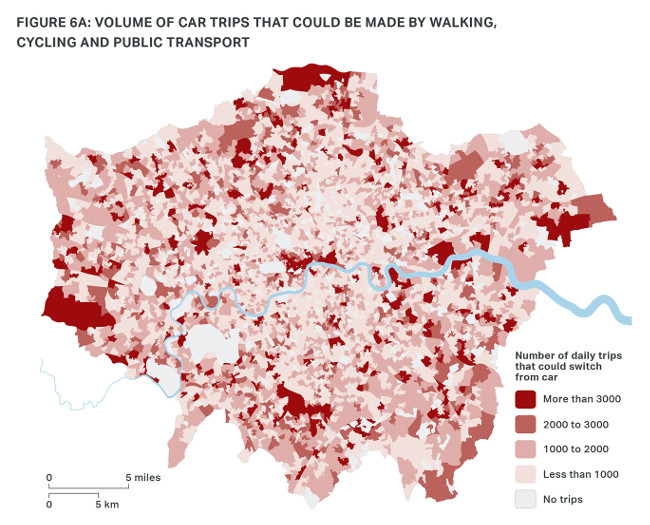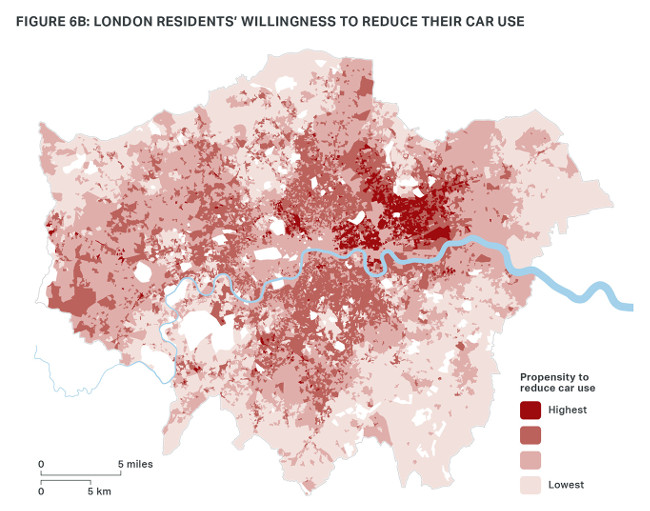Alex Williams, director of city planning at Transport for London, talks to Transport Network about mayor Sadiq Khan's draft transport strategy, which includes proposals for per mile road user charging.
What is the feeling about the approach of the public to the strategy. Are you expecting a negative reaction to road user charging?
This is a comprehensive strategy for the next 25 years dealing with the feel of streets, the quality of the public transport offer, and how we need to enhance it, looking at capacity to help deliver new homes and jobs, so that a core part of the document.
To get to that ambitious mode shift target of 80% we need to look at issues about how we manage the road network, whether you do also need to shift to a distance-based road charging system. Yes, 64% of journeys are currently made by sustainable modes - walking cycling and public transport. That has increased from 53% 15 years ago; in 2015 it was 64%. And the aim is by 2041 to get it up to 80%.
We will have to see how the public reacts. This document has been drafted with an extensive pre consultation. Several hundred people were involved in the discussions around this document. There is an appetite to support a big shift to sustainable modes but also keep open that debate about how we manage and pay for our roads. It is worth noting this is the third Mayor’s Transport Strategy. Every single one of them has had policies of road pricing. It would be completely negligent of us not to include something on that issue.
How far would a per mile charging area cover?
We are just flagging up in the [strategy] the need for a policy foundation to look at that issue in more detail. We haven’t got a detailed proposal. With a plan over 25 years you need to think about what the city will need when it grows from 8.6 million up to 10.5 million. That puts big pressure on the transport network. We are looking at extra capacity to deal with that but also you need to look at different ways of managing the road network. The document gives us the policy support and foundation. There is not a detailed proposal.

Source: London Mayor's Transport Strategy
How easy would it be for you introduce road user charging?
The legal framework already exists. It was in the Greater London Authority Act. There is no legal impediment to do that. We have those powers. If we need to seek any extra powers the mayor will do that.
On the one hand you are trying to reduce car use but road user charging would be a useful form of income. How do you balance those two things? Isn’t there a point where you don’t want to reduce car use by anymore?
We are not applying that kind of logic to it. The air quality initiatives that we are putting in with the ULEV schemes – there is a charge if a vehicle doesn’t comply but the objective is not to make money: it is to change people’s behaviours.
The ULEV scheme over several years will probably lose money but the objective is not a financial one: it’s cleaning up London’s air. What we are trying to achieve is a sustainable and growing city. The distance based charging system – the [strategy] gives us the policy support and foundation for it. There is not a worked up proposal. We are not there yet.
You also talk about areas that are ‘well served’ by public transport being designed to be car-free. How do you define well served?
You have a well known measurement tool called the Public Transport Accessibility Levels (PTAL). That goes from 6 to zero; zero is low accessibility. On the outer fringes of London some areas are zero. Whereas in a place like King’s Cross you go up to 6b. What we are saying - and the London plan will endorse this – is where there is a good quality public transport offer you should be looking to minimise the amount of parking in new developments. The best is to go for car free elements, which have existed in London for 20 years now.
Do you have a level of PTAL where you would say above this you have to design for car-free?
We don’t have a threshold to say it will always be car-free over a certain level. We are flagging the principle that where you have a good transport offer you should be looking to minimise parking and if possible making it zero. I would say in certain areas it’s not appropriate, where there is poor public transport people will be reliant on cars. However the majority of the development is in areas of good public transport, and accessibility and we should be looking to reduce off-street parking in those developments.
How would you enforce this? Would developments be refused planning permission?
It is a matter for the boroughs and we expect the boroughs to look at planning policies and transport policies that are in conformity with the Mayor’s Transport Strategy and also the next version plan. For the large developments, they are referred to the mayor for him to make a decisions as to whether they are acceptable. So the mayor has the ability to direct refusal if he believes developments do not conform with the London plan and the [strategy] so that power is there for the larger developments for a lot of the smaller stuff it’s a borough decisions as they are the local planning authority.
So would any big retail development have to have to be built near a Tube stop?
Most of them are. The retail centres that were built in the last 10 to 30 years with large amounts of off-street car parking they are converting their car parking to retail. That is exactly what Westfield are doing in Stratford. These shopping centres were built with a large amount of parking but the reality is when it’s near an excellent public transport offer people aren’t using it. It’s not the most efficient use of land so they are converting the parking onto retail. That is the economic reality - if you provide good public transport or a street network where people can walk or cycle people choose to do that.
Is this plan preparing us for driverless vehicles and different models of car ownership?
I think there are likely to be different models – car clubs and those kind of systems, which are becoming more prevalent in London. So I think that is an indication of the shift of ownership models. I think clearly with developments, particularly residential developments, you need to think about the parking for people with disabilities. But I think the whole direction of travel is to reduce the amount of off-street parking constructed in these developments to encourage mode shift and more productive and better use of land.

Source: London Mayor's Transport Strategy
You make a big and welcome commitment to accessibility. How will you pay for all of this once your grant is taken away?
The thing to bear in mind is our business plan goes for the next four years or so. This strategy goes for the next 25 years, if we constrain that ambition to what we can only afford in the present day we would be doing a disservice to the city because we need to think about projects and proposals that go well beyond the life of the business plan.
On the specifics of step-free, one of the things we have in the MTS is an accessibility road map and that’s looking at how we will make the network more accessible in five year chunks up to 2041. There is a lot of stuff in terms of the softer side – customer service and experience, signage, how it links in with the street environment, as well as improving step-free access at stations.
Any new infrastructure clearly will be step-free. It creates a challenge and the document does talk about funding and financing flexibilities that we need to see apply to London so that the tax generated in London, so that the tax generated in London is spent in London stuff like land value capture vehicle excise duty those types of things. There is a lobbying case there but the strategy should go beyond what is in the business plan now.
On the street scene, what is the vision? Can we expect more areas like Exhibition Road i.e. open plan pedestrianised areas?
For trips within central London the dominant mode is pedestrian and the conditions for pedestrians are not as good as they should be in many parts of London. We are looking at Oxford Street [and] Parliament Square. What the City has done in Bank where it is about prioritising the pedestrian or other sustainable modes and general traffic has to be pushed further afield. So we have those flagship projects in central London but we are also working with the boroughs on similar projects on outer London town centres as well. This push to sustainable modes has significant implications about how we manage the road network.
We are not promoting shared space’ we are promoting better conditions for pedestrians. Shared space works in Exhibition Road; it may not work in Oxford Street. The strategy isn’t saying we want more shared space. It’s saying we want better conditions to encourage people to walk and cycle and use public transport. If that is done through shared space – fine [but] it doesn’t have to be from our perspective.
You talk about making life better for pedestrians, what do you think pedestrians want?
I think the Healthy Streets initiative in this document is a key part of what we are asking for. I think it is looking for the street as a whole – looking at the ambience, the quality of the public realm, the air the noisiness, the ability to dwell with ease, the sense of safety and security.
The healthy streets approach is focused on improving conditions for pedestrians but it is really a genuinely holistic approach to how we manage the public realm across the city. When you speak to the boroughs, of all persuasions, they are really up for this. And that’s very pleasing.
Register now for full access
Register just once to get unrestricted, real-time coverage of the issues and challenges facing UK transport and highways engineers.
Full website content includes the latest news, exclusive commentary from leading industry figures and detailed topical analysis of the highways, transportation, environment and place-shaping sectors.
Use the link below to register your details for full, free access.
Already a registered? Login